Comparative Financial Analysis of Tesco and Marks & Spencer
VerifiedAdded on 2020/06/06
|9
|2237
|37
Report
AI Summary
This report presents a comparative financial analysis of Tesco and Marks & Spencer, two major players in the retail sector. It begins with an introduction to ratio analysis, emphasizing its importance in evaluating a company's financial health and performance over time and in comparison to competit...
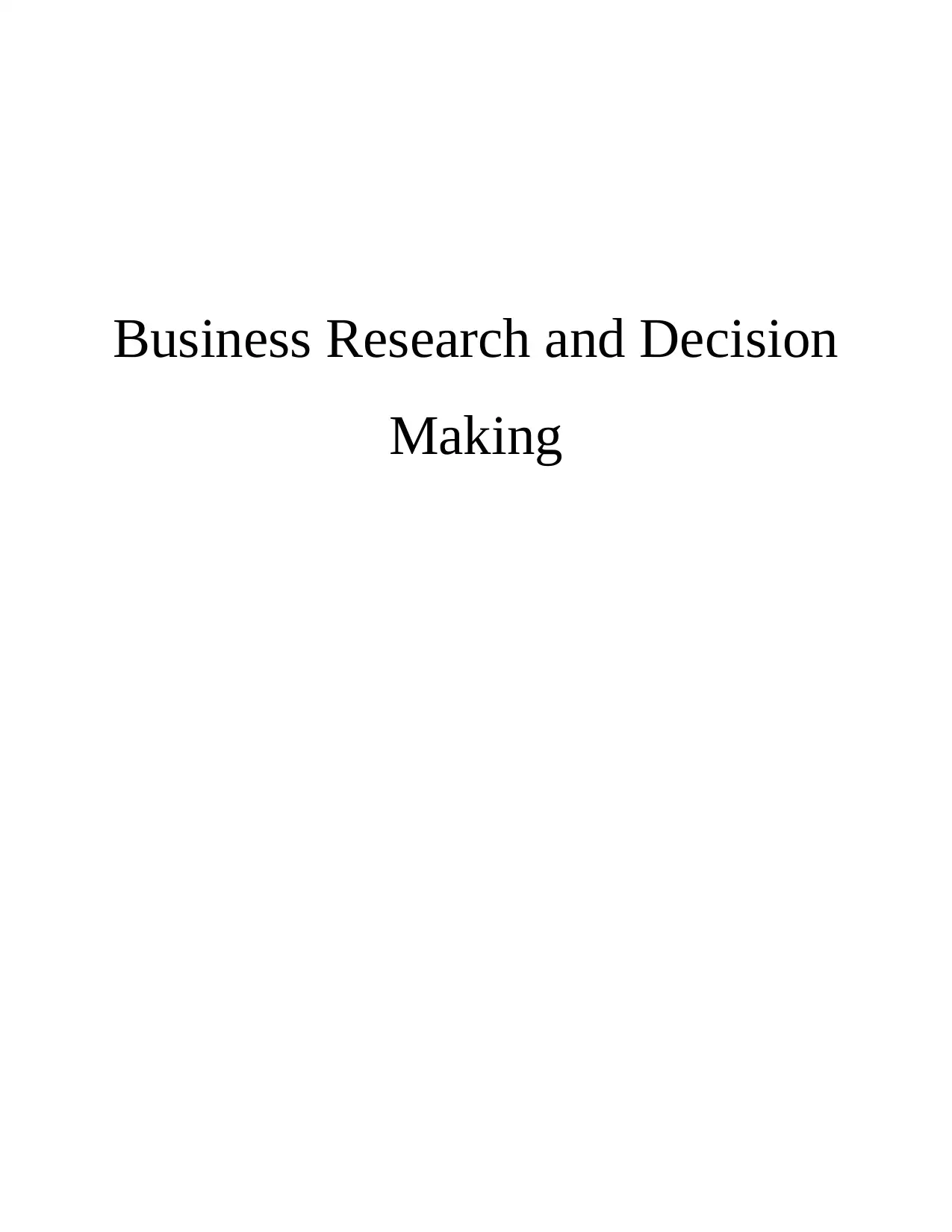
Business Research and Decision
Making
Making
Paraphrase This Document
Need a fresh take? Get an instant paraphrase of this document with our AI Paraphraser
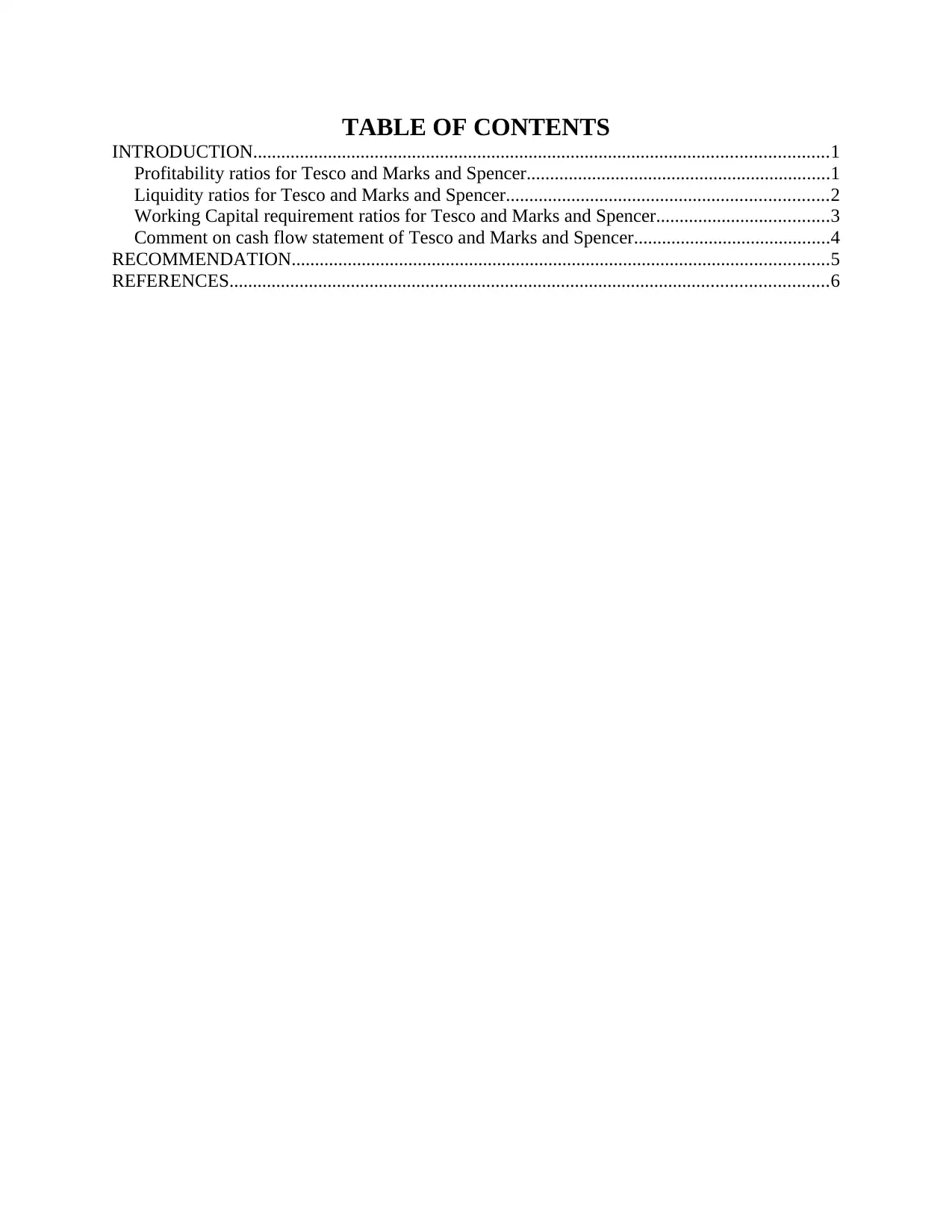
TABLE OF CONTENTS
INTRODUCTION...........................................................................................................................1
Profitability ratios for Tesco and Marks and Spencer.................................................................1
Liquidity ratios for Tesco and Marks and Spencer.....................................................................2
Working Capital requirement ratios for Tesco and Marks and Spencer.....................................3
Comment on cash flow statement of Tesco and Marks and Spencer..........................................4
RECOMMENDATION...................................................................................................................5
REFERENCES................................................................................................................................6
INTRODUCTION...........................................................................................................................1
Profitability ratios for Tesco and Marks and Spencer.................................................................1
Liquidity ratios for Tesco and Marks and Spencer.....................................................................2
Working Capital requirement ratios for Tesco and Marks and Spencer.....................................3
Comment on cash flow statement of Tesco and Marks and Spencer..........................................4
RECOMMENDATION...................................................................................................................5
REFERENCES................................................................................................................................6
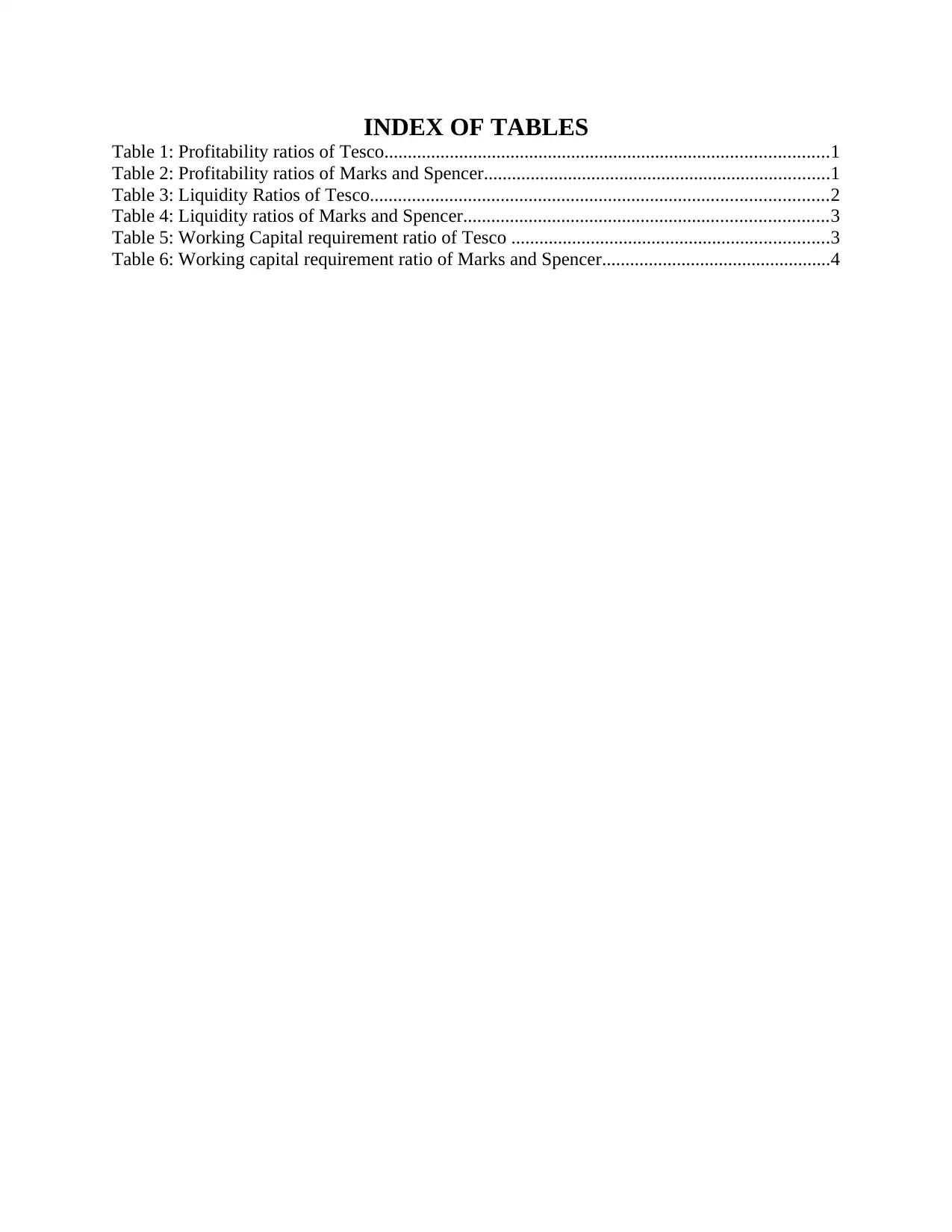
INDEX OF TABLES
Table 1: Profitability ratios of Tesco...............................................................................................1
Table 2: Profitability ratios of Marks and Spencer..........................................................................1
Table 3: Liquidity Ratios of Tesco..................................................................................................2
Table 4: Liquidity ratios of Marks and Spencer..............................................................................3
Table 5: Working Capital requirement ratio of Tesco ....................................................................3
Table 6: Working capital requirement ratio of Marks and Spencer.................................................4
Table 1: Profitability ratios of Tesco...............................................................................................1
Table 2: Profitability ratios of Marks and Spencer..........................................................................1
Table 3: Liquidity Ratios of Tesco..................................................................................................2
Table 4: Liquidity ratios of Marks and Spencer..............................................................................3
Table 5: Working Capital requirement ratio of Tesco ....................................................................3
Table 6: Working capital requirement ratio of Marks and Spencer.................................................4
You're viewing a preview
Unlock full access by subscribing today!
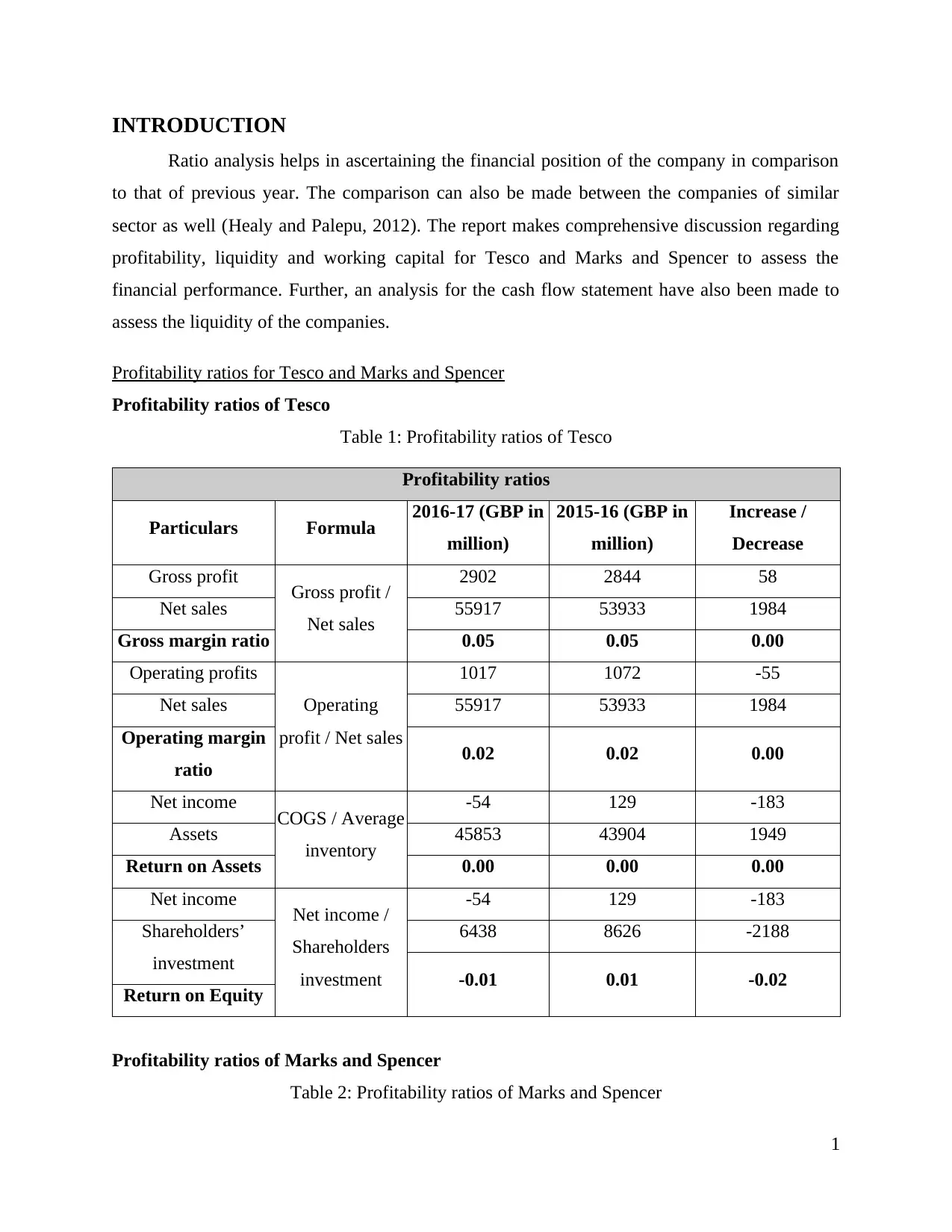
INTRODUCTION
Ratio analysis helps in ascertaining the financial position of the company in comparison
to that of previous year. The comparison can also be made between the companies of similar
sector as well (Healy and Palepu, 2012). The report makes comprehensive discussion regarding
profitability, liquidity and working capital for Tesco and Marks and Spencer to assess the
financial performance. Further, an analysis for the cash flow statement have also been made to
assess the liquidity of the companies.
Profitability ratios for Tesco and Marks and Spencer
Profitability ratios of Tesco
Table 1: Profitability ratios of Tesco
Profitability ratios
Particulars Formula 2016-17 (GBP in
million)
2015-16 (GBP in
million)
Increase /
Decrease
Gross profit Gross profit /
Net sales
2902 2844 58
Net sales 55917 53933 1984
Gross margin ratio 0.05 0.05 0.00
Operating profits
Operating
profit / Net sales
1017 1072 -55
Net sales 55917 53933 1984
Operating margin
ratio 0.02 0.02 0.00
Net income COGS / Average
inventory
-54 129 -183
Assets 45853 43904 1949
Return on Assets 0.00 0.00 0.00
Net income Net income /
Shareholders
investment
-54 129 -183
Shareholders’
investment
6438 8626 -2188
-0.01 0.01 -0.02
Return on Equity
Profitability ratios of Marks and Spencer
Table 2: Profitability ratios of Marks and Spencer
1
Ratio analysis helps in ascertaining the financial position of the company in comparison
to that of previous year. The comparison can also be made between the companies of similar
sector as well (Healy and Palepu, 2012). The report makes comprehensive discussion regarding
profitability, liquidity and working capital for Tesco and Marks and Spencer to assess the
financial performance. Further, an analysis for the cash flow statement have also been made to
assess the liquidity of the companies.
Profitability ratios for Tesco and Marks and Spencer
Profitability ratios of Tesco
Table 1: Profitability ratios of Tesco
Profitability ratios
Particulars Formula 2016-17 (GBP in
million)
2015-16 (GBP in
million)
Increase /
Decrease
Gross profit Gross profit /
Net sales
2902 2844 58
Net sales 55917 53933 1984
Gross margin ratio 0.05 0.05 0.00
Operating profits
Operating
profit / Net sales
1017 1072 -55
Net sales 55917 53933 1984
Operating margin
ratio 0.02 0.02 0.00
Net income COGS / Average
inventory
-54 129 -183
Assets 45853 43904 1949
Return on Assets 0.00 0.00 0.00
Net income Net income /
Shareholders
investment
-54 129 -183
Shareholders’
investment
6438 8626 -2188
-0.01 0.01 -0.02
Return on Equity
Profitability ratios of Marks and Spencer
Table 2: Profitability ratios of Marks and Spencer
1
Paraphrase This Document
Need a fresh take? Get an instant paraphrase of this document with our AI Paraphraser
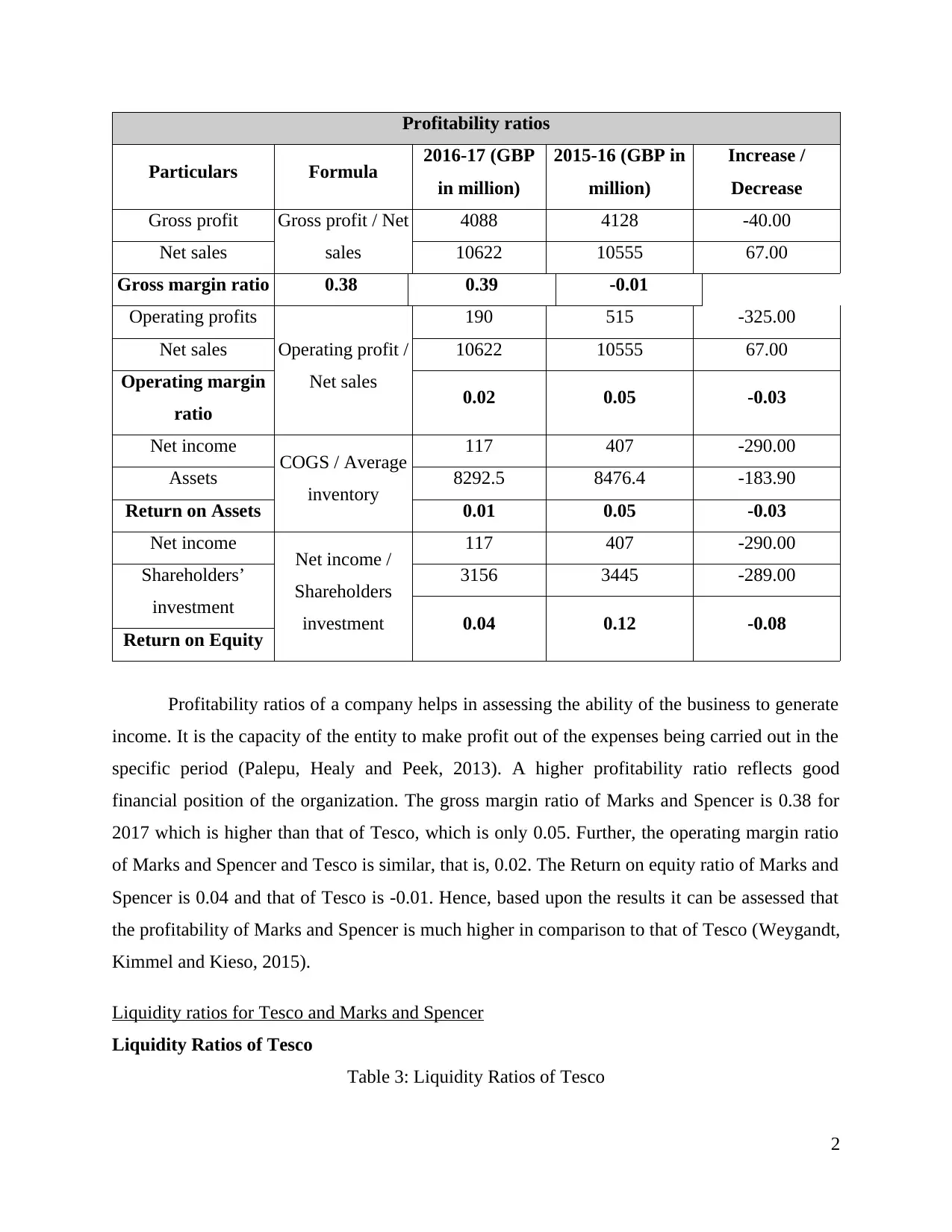
Profitability ratios
Particulars Formula 2016-17 (GBP
in million)
2015-16 (GBP in
million)
Increase /
Decrease
Gross profit Gross profit / Net
sales
4088 4128 -40.00
Net sales 10622 10555 67.00
Gross margin ratio 0.38 0.39 -0.01
Operating profits
Operating profit /
Net sales
190 515 -325.00
Net sales 10622 10555 67.00
Operating margin
ratio 0.02 0.05 -0.03
Net income COGS / Average
inventory
117 407 -290.00
Assets 8292.5 8476.4 -183.90
Return on Assets 0.01 0.05 -0.03
Net income Net income /
Shareholders
investment
117 407 -290.00
Shareholders’
investment
3156 3445 -289.00
0.04 0.12 -0.08
Return on Equity
Profitability ratios of a company helps in assessing the ability of the business to generate
income. It is the capacity of the entity to make profit out of the expenses being carried out in the
specific period (Palepu, Healy and Peek, 2013). A higher profitability ratio reflects good
financial position of the organization. The gross margin ratio of Marks and Spencer is 0.38 for
2017 which is higher than that of Tesco, which is only 0.05. Further, the operating margin ratio
of Marks and Spencer and Tesco is similar, that is, 0.02. The Return on equity ratio of Marks and
Spencer is 0.04 and that of Tesco is -0.01. Hence, based upon the results it can be assessed that
the profitability of Marks and Spencer is much higher in comparison to that of Tesco (Weygandt,
Kimmel and Kieso, 2015).
Liquidity ratios for Tesco and Marks and Spencer
Liquidity Ratios of Tesco
Table 3: Liquidity Ratios of Tesco
2
Particulars Formula 2016-17 (GBP
in million)
2015-16 (GBP in
million)
Increase /
Decrease
Gross profit Gross profit / Net
sales
4088 4128 -40.00
Net sales 10622 10555 67.00
Gross margin ratio 0.38 0.39 -0.01
Operating profits
Operating profit /
Net sales
190 515 -325.00
Net sales 10622 10555 67.00
Operating margin
ratio 0.02 0.05 -0.03
Net income COGS / Average
inventory
117 407 -290.00
Assets 8292.5 8476.4 -183.90
Return on Assets 0.01 0.05 -0.03
Net income Net income /
Shareholders
investment
117 407 -290.00
Shareholders’
investment
3156 3445 -289.00
0.04 0.12 -0.08
Return on Equity
Profitability ratios of a company helps in assessing the ability of the business to generate
income. It is the capacity of the entity to make profit out of the expenses being carried out in the
specific period (Palepu, Healy and Peek, 2013). A higher profitability ratio reflects good
financial position of the organization. The gross margin ratio of Marks and Spencer is 0.38 for
2017 which is higher than that of Tesco, which is only 0.05. Further, the operating margin ratio
of Marks and Spencer and Tesco is similar, that is, 0.02. The Return on equity ratio of Marks and
Spencer is 0.04 and that of Tesco is -0.01. Hence, based upon the results it can be assessed that
the profitability of Marks and Spencer is much higher in comparison to that of Tesco (Weygandt,
Kimmel and Kieso, 2015).
Liquidity ratios for Tesco and Marks and Spencer
Liquidity Ratios of Tesco
Table 3: Liquidity Ratios of Tesco
2
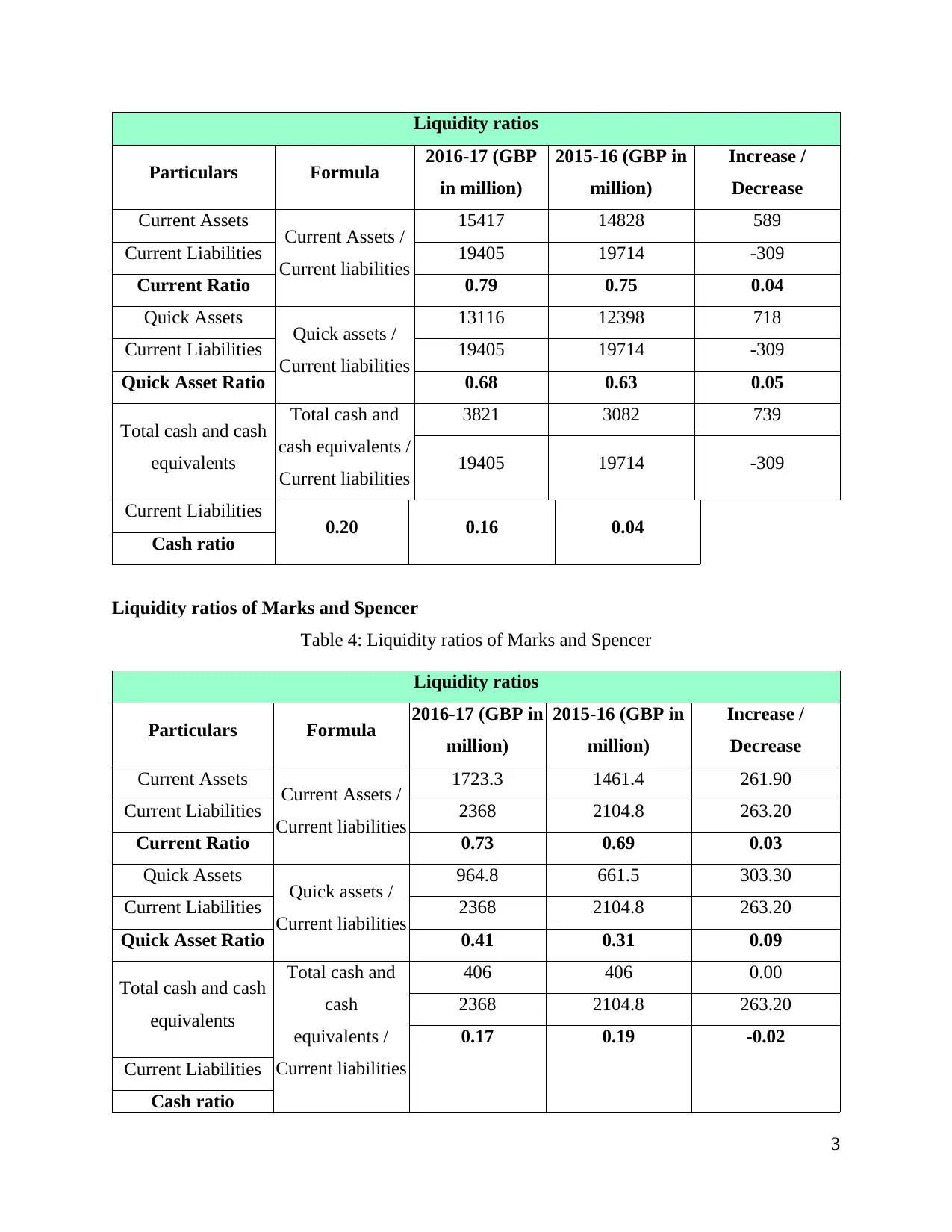
Liquidity ratios
Particulars Formula 2016-17 (GBP
in million)
2015-16 (GBP in
million)
Increase /
Decrease
Current Assets Current Assets /
Current liabilities
15417 14828 589
Current Liabilities 19405 19714 -309
Current Ratio 0.79 0.75 0.04
Quick Assets Quick assets /
Current liabilities
13116 12398 718
Current Liabilities 19405 19714 -309
Quick Asset Ratio 0.68 0.63 0.05
Total cash and cash
equivalents
Total cash and
cash equivalents /
Current liabilities
3821 3082 739
19405 19714 -309
Current Liabilities 0.20 0.16 0.04
Cash ratio
Liquidity ratios of Marks and Spencer
Table 4: Liquidity ratios of Marks and Spencer
Liquidity ratios
Particulars Formula 2016-17 (GBP in
million)
2015-16 (GBP in
million)
Increase /
Decrease
Current Assets Current Assets /
Current liabilities
1723.3 1461.4 261.90
Current Liabilities 2368 2104.8 263.20
Current Ratio 0.73 0.69 0.03
Quick Assets Quick assets /
Current liabilities
964.8 661.5 303.30
Current Liabilities 2368 2104.8 263.20
Quick Asset Ratio 0.41 0.31 0.09
Total cash and cash
equivalents
Total cash and
cash
equivalents /
Current liabilities
406 406 0.00
2368 2104.8 263.20
0.17 0.19 -0.02
Current Liabilities
Cash ratio
3
Particulars Formula 2016-17 (GBP
in million)
2015-16 (GBP in
million)
Increase /
Decrease
Current Assets Current Assets /
Current liabilities
15417 14828 589
Current Liabilities 19405 19714 -309
Current Ratio 0.79 0.75 0.04
Quick Assets Quick assets /
Current liabilities
13116 12398 718
Current Liabilities 19405 19714 -309
Quick Asset Ratio 0.68 0.63 0.05
Total cash and cash
equivalents
Total cash and
cash equivalents /
Current liabilities
3821 3082 739
19405 19714 -309
Current Liabilities 0.20 0.16 0.04
Cash ratio
Liquidity ratios of Marks and Spencer
Table 4: Liquidity ratios of Marks and Spencer
Liquidity ratios
Particulars Formula 2016-17 (GBP in
million)
2015-16 (GBP in
million)
Increase /
Decrease
Current Assets Current Assets /
Current liabilities
1723.3 1461.4 261.90
Current Liabilities 2368 2104.8 263.20
Current Ratio 0.73 0.69 0.03
Quick Assets Quick assets /
Current liabilities
964.8 661.5 303.30
Current Liabilities 2368 2104.8 263.20
Quick Asset Ratio 0.41 0.31 0.09
Total cash and cash
equivalents
Total cash and
cash
equivalents /
Current liabilities
406 406 0.00
2368 2104.8 263.20
0.17 0.19 -0.02
Current Liabilities
Cash ratio
3
You're viewing a preview
Unlock full access by subscribing today!
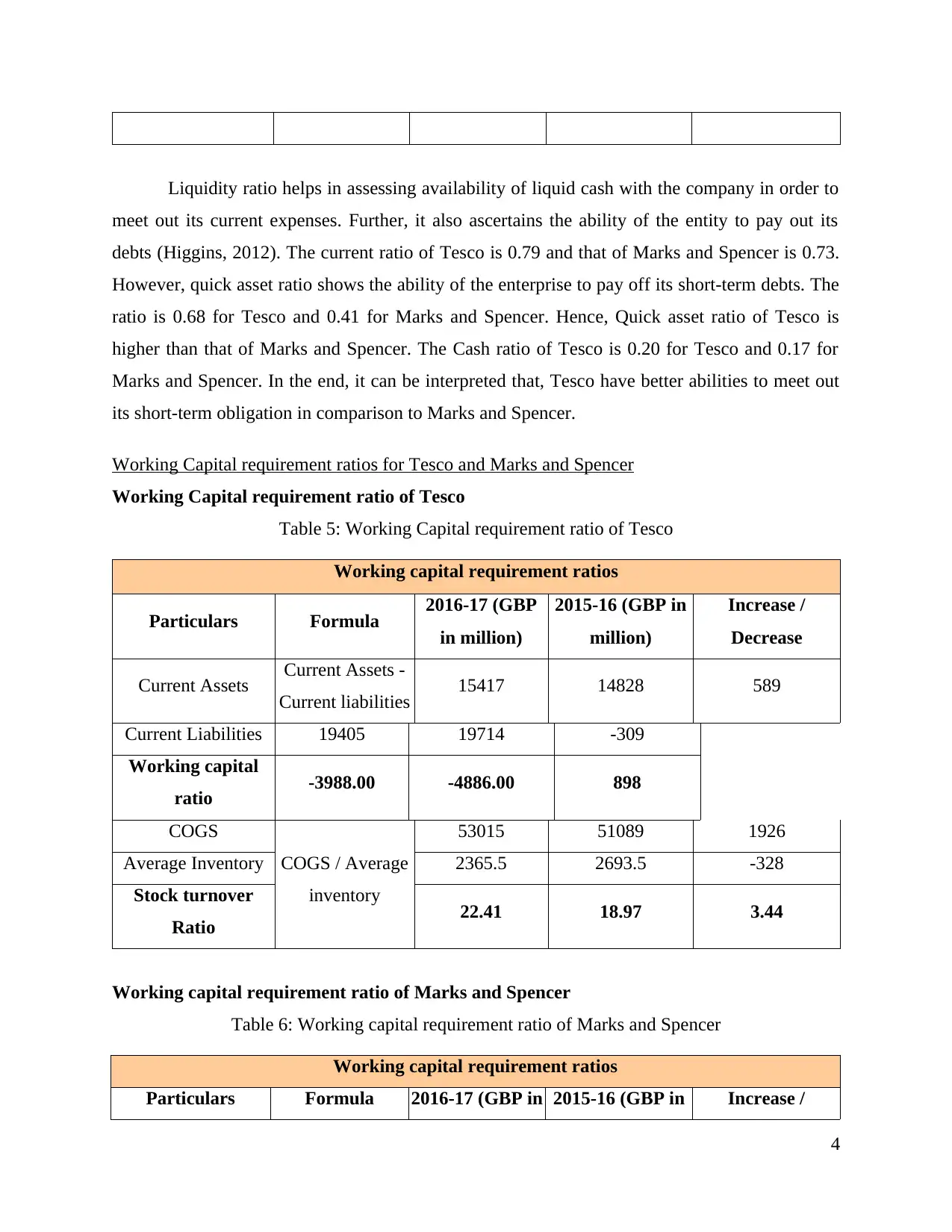
Liquidity ratio helps in assessing availability of liquid cash with the company in order to
meet out its current expenses. Further, it also ascertains the ability of the entity to pay out its
debts (Higgins, 2012). The current ratio of Tesco is 0.79 and that of Marks and Spencer is 0.73.
However, quick asset ratio shows the ability of the enterprise to pay off its short-term debts. The
ratio is 0.68 for Tesco and 0.41 for Marks and Spencer. Hence, Quick asset ratio of Tesco is
higher than that of Marks and Spencer. The Cash ratio of Tesco is 0.20 for Tesco and 0.17 for
Marks and Spencer. In the end, it can be interpreted that, Tesco have better abilities to meet out
its short-term obligation in comparison to Marks and Spencer.
Working Capital requirement ratios for Tesco and Marks and Spencer
Working Capital requirement ratio of Tesco
Table 5: Working Capital requirement ratio of Tesco
Working capital requirement ratios
Particulars Formula 2016-17 (GBP
in million)
2015-16 (GBP in
million)
Increase /
Decrease
Current Assets Current Assets -
Current liabilities 15417 14828 589
Current Liabilities 19405 19714 -309
Working capital
ratio -3988.00 -4886.00 898
COGS
COGS / Average
inventory
53015 51089 1926
Average Inventory 2365.5 2693.5 -328
Stock turnover
Ratio 22.41 18.97 3.44
Working capital requirement ratio of Marks and Spencer
Table 6: Working capital requirement ratio of Marks and Spencer
Working capital requirement ratios
Particulars Formula 2016-17 (GBP in 2015-16 (GBP in Increase /
4
meet out its current expenses. Further, it also ascertains the ability of the entity to pay out its
debts (Higgins, 2012). The current ratio of Tesco is 0.79 and that of Marks and Spencer is 0.73.
However, quick asset ratio shows the ability of the enterprise to pay off its short-term debts. The
ratio is 0.68 for Tesco and 0.41 for Marks and Spencer. Hence, Quick asset ratio of Tesco is
higher than that of Marks and Spencer. The Cash ratio of Tesco is 0.20 for Tesco and 0.17 for
Marks and Spencer. In the end, it can be interpreted that, Tesco have better abilities to meet out
its short-term obligation in comparison to Marks and Spencer.
Working Capital requirement ratios for Tesco and Marks and Spencer
Working Capital requirement ratio of Tesco
Table 5: Working Capital requirement ratio of Tesco
Working capital requirement ratios
Particulars Formula 2016-17 (GBP
in million)
2015-16 (GBP in
million)
Increase /
Decrease
Current Assets Current Assets -
Current liabilities 15417 14828 589
Current Liabilities 19405 19714 -309
Working capital
ratio -3988.00 -4886.00 898
COGS
COGS / Average
inventory
53015 51089 1926
Average Inventory 2365.5 2693.5 -328
Stock turnover
Ratio 22.41 18.97 3.44
Working capital requirement ratio of Marks and Spencer
Table 6: Working capital requirement ratio of Marks and Spencer
Working capital requirement ratios
Particulars Formula 2016-17 (GBP in 2015-16 (GBP in Increase /
4
Paraphrase This Document
Need a fresh take? Get an instant paraphrase of this document with our AI Paraphraser
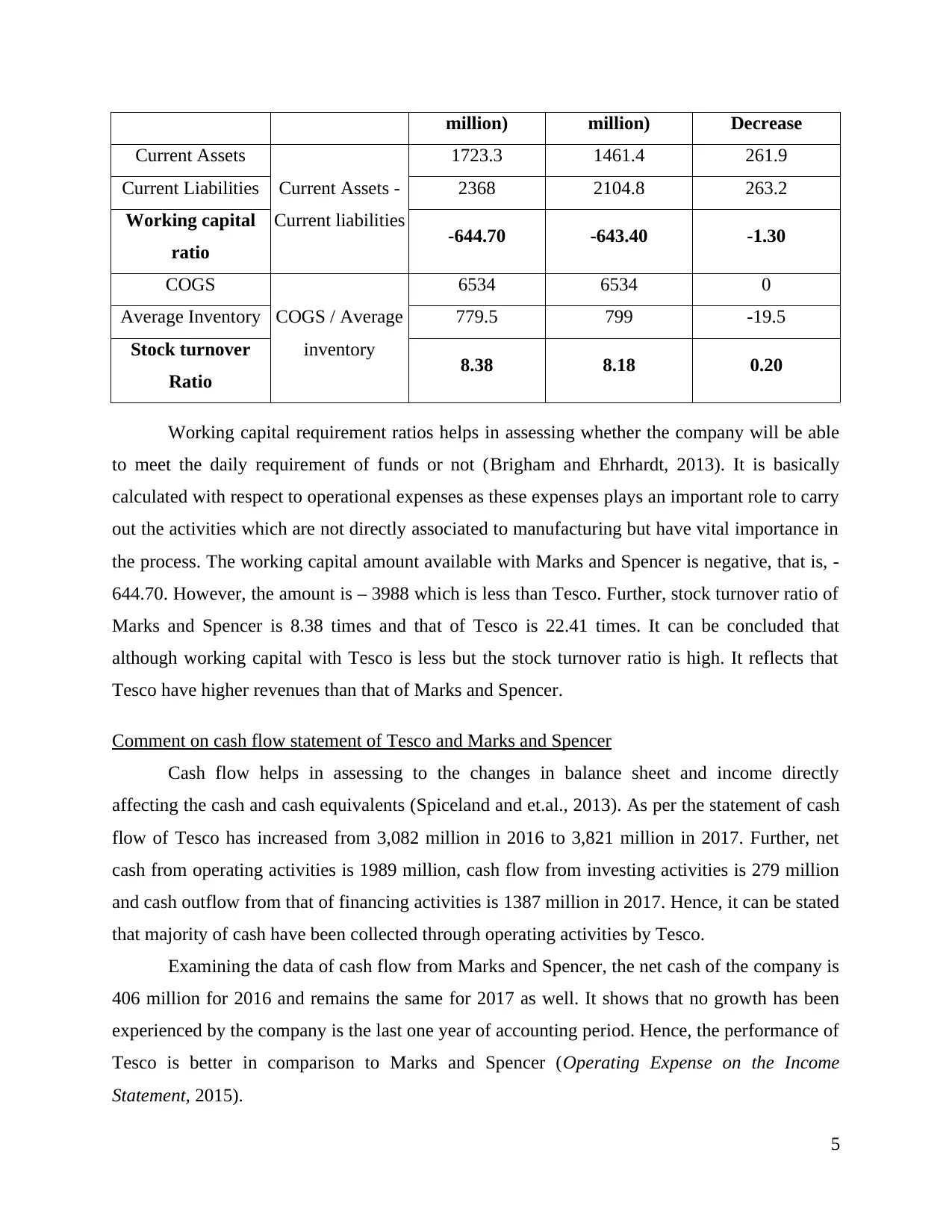
million) million) Decrease
Current Assets
Current Assets -
Current liabilities
1723.3 1461.4 261.9
Current Liabilities 2368 2104.8 263.2
Working capital
ratio -644.70 -643.40 -1.30
COGS
COGS / Average
inventory
6534 6534 0
Average Inventory 779.5 799 -19.5
Stock turnover
Ratio 8.38 8.18 0.20
Working capital requirement ratios helps in assessing whether the company will be able
to meet the daily requirement of funds or not (Brigham and Ehrhardt, 2013). It is basically
calculated with respect to operational expenses as these expenses plays an important role to carry
out the activities which are not directly associated to manufacturing but have vital importance in
the process. The working capital amount available with Marks and Spencer is negative, that is, -
644.70. However, the amount is – 3988 which is less than Tesco. Further, stock turnover ratio of
Marks and Spencer is 8.38 times and that of Tesco is 22.41 times. It can be concluded that
although working capital with Tesco is less but the stock turnover ratio is high. It reflects that
Tesco have higher revenues than that of Marks and Spencer.
Comment on cash flow statement of Tesco and Marks and Spencer
Cash flow helps in assessing to the changes in balance sheet and income directly
affecting the cash and cash equivalents (Spiceland and et.al., 2013). As per the statement of cash
flow of Tesco has increased from 3,082 million in 2016 to 3,821 million in 2017. Further, net
cash from operating activities is 1989 million, cash flow from investing activities is 279 million
and cash outflow from that of financing activities is 1387 million in 2017. Hence, it can be stated
that majority of cash have been collected through operating activities by Tesco.
Examining the data of cash flow from Marks and Spencer, the net cash of the company is
406 million for 2016 and remains the same for 2017 as well. It shows that no growth has been
experienced by the company is the last one year of accounting period. Hence, the performance of
Tesco is better in comparison to Marks and Spencer (Operating Expense on the Income
Statement, 2015).
5
Current Assets
Current Assets -
Current liabilities
1723.3 1461.4 261.9
Current Liabilities 2368 2104.8 263.2
Working capital
ratio -644.70 -643.40 -1.30
COGS
COGS / Average
inventory
6534 6534 0
Average Inventory 779.5 799 -19.5
Stock turnover
Ratio 8.38 8.18 0.20
Working capital requirement ratios helps in assessing whether the company will be able
to meet the daily requirement of funds or not (Brigham and Ehrhardt, 2013). It is basically
calculated with respect to operational expenses as these expenses plays an important role to carry
out the activities which are not directly associated to manufacturing but have vital importance in
the process. The working capital amount available with Marks and Spencer is negative, that is, -
644.70. However, the amount is – 3988 which is less than Tesco. Further, stock turnover ratio of
Marks and Spencer is 8.38 times and that of Tesco is 22.41 times. It can be concluded that
although working capital with Tesco is less but the stock turnover ratio is high. It reflects that
Tesco have higher revenues than that of Marks and Spencer.
Comment on cash flow statement of Tesco and Marks and Spencer
Cash flow helps in assessing to the changes in balance sheet and income directly
affecting the cash and cash equivalents (Spiceland and et.al., 2013). As per the statement of cash
flow of Tesco has increased from 3,082 million in 2016 to 3,821 million in 2017. Further, net
cash from operating activities is 1989 million, cash flow from investing activities is 279 million
and cash outflow from that of financing activities is 1387 million in 2017. Hence, it can be stated
that majority of cash have been collected through operating activities by Tesco.
Examining the data of cash flow from Marks and Spencer, the net cash of the company is
406 million for 2016 and remains the same for 2017 as well. It shows that no growth has been
experienced by the company is the last one year of accounting period. Hence, the performance of
Tesco is better in comparison to Marks and Spencer (Operating Expense on the Income
Statement, 2015).
5
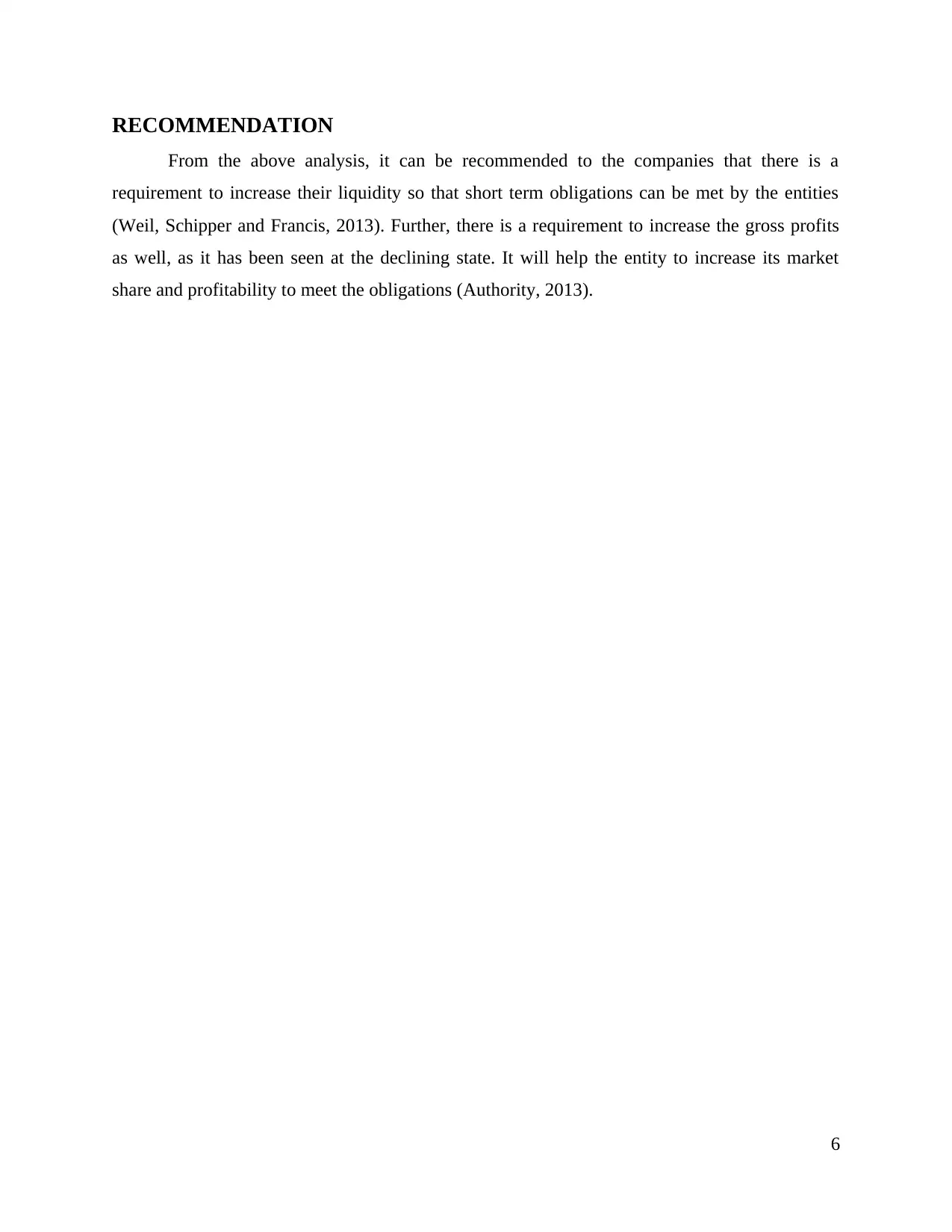
RECOMMENDATION
From the above analysis, it can be recommended to the companies that there is a
requirement to increase their liquidity so that short term obligations can be met by the entities
(Weil, Schipper and Francis, 2013). Further, there is a requirement to increase the gross profits
as well, as it has been seen at the declining state. It will help the entity to increase its market
share and profitability to meet the obligations (Authority, 2013).
6
From the above analysis, it can be recommended to the companies that there is a
requirement to increase their liquidity so that short term obligations can be met by the entities
(Weil, Schipper and Francis, 2013). Further, there is a requirement to increase the gross profits
as well, as it has been seen at the declining state. It will help the entity to increase its market
share and profitability to meet the obligations (Authority, 2013).
6
You're viewing a preview
Unlock full access by subscribing today!
1 out of 9
Related Documents
Your All-in-One AI-Powered Toolkit for Academic Success.
+13062052269
info@desklib.com
Available 24*7 on WhatsApp / Email
![[object Object]](/_next/static/media/star-bottom.7253800d.svg)
Unlock your academic potential
© 2024 | Zucol Services PVT LTD | All rights reserved.





